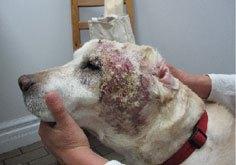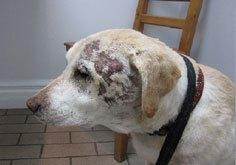Healing with photon energy: Laser therapy for horses and dogs, equine laser therapy.
Equine laser therapy (laser therapy for horse and dogs) can be used as a stand-alone therapy, as an adjunctive to common treatments and it can easily be combined with other therapies and medicaments. The RJ laser devices are made for application to individual points, reflex therapy and for local treatment of small and large areas.
RJ Laser has thousands of satisfied veterinary customers worldwide who have been using the laser devices successfully for many years and RJ develops the laser devices in close cooperation with leading therapists. Benefit from the experience of RJ and our customers.
Laser acupuncture

Laser therapy, photobiomodulation is packed with research
To learn acupuncture and laser therapy just join the international academies as IVAS, seminars of the European Academy TCM Laser Therapy, seminars of Dr. Uwe Petermann.
Laser beam/tissue

Radiation behaviour in the tissue and coat of horses and dogs
The crucial point in laser therapy for horses and dogs is the coat/fur and the color. If the fur is to tight, too thick, a large amount of the laser energy will be absorbed already before reaching the tissue and deeper layers. Therefor you either must shave the fur of the animal or use a special applicator which can push the hair away (RJ offers such applicator). If the color of the fur/skin is dark the laser beam will be absorbed in relation to the color tone. In any case use laser diodes with wave lengths of the "optical window" only.
Case reports - equine laser therapy, wound healing in veterinary medicine
Before laser therapy

Middle of the treatment

After laser therapy

Report from Leszek Ryś, Poland - Laser therapy for horses, COPD
COB (chronic obstructive bronchitis) or COPD (chronic obstructive pulmonary disease) is generally difficult to treat. The course of laser therapy shows how healing can be achieved by means of pulse-controlled laser acupuncture (Physiolaser 90 W/904 nm superpulsed). The laser therapy was performed by
Dr. Uwe Petermann is the discoverer of COB treatment with pulse-controlled laser acupuncture. Detailed information can be found on his website. The dissertation of Dr. Astrid Reiz confirmed the results of Dr. Uwe Petermann. Download (German language):
Comparison of therapeutic effects of laser acupuncture and medical therapy in COPD of horses
Before laser therapy

Middle of the treatment

After laser therapy

Case report from Cindy Kneebone, Canada - Laser therapy for dogs
American Bulldog, FS, born 1997.Laser therapy in veterinary medicine is common since many years for dogs. Initial start of our vet laser therapy was in November 2007 - treated with a number of antibiotics and steriods, condition worsened. Referred to a dermatologist: 1 1/2 year using various antibiotics, steroids, topical tacrolimis and oral pentoxifylline.
Lesion was a deep, wet oozing ulcer under the tail approx 1 inch diameter. Began the UV vet laser laser treatment first on May 14th. Started at 10mins on tail and 10 mins on perineum. Repeated May 19th - tail and perineum was dry and dog didn't bother at it anymore. All medications stopped as of May 14th. Next vet laser treatments with UV lasers May 20, 25, June 5, 22, and July 21st (last vet laser treatment - healed).
Before laser therapy

After laser therapy

Wound management (chronic wound) - Laser therapy for dogs
11 year old yellow lab.
Came to us from the Emergency clinic, from dermatology. Been through a number of therapies including a number of antibiotics. Diagnosed in May 2010 with methicillin restistant Staphylococcus pseudointermedius. Prognosis was poor for this patient. She came to us in fear of losing her dog and the fear of this pet being contagious to the population in general. Two weeks with the use of the ultraviolet laser twice a week for 10 minutes. See the healing we achieved within two weeks. The skin was also thickened and has become nearly normal thickness as our treatments continue.
Case report from Cindy Kneebone, Canada
Before laser therapy

Middle of the treatment

After laser therapy

Wound management (chronic healing disorder) - Laser therapy for horses
The horse suffered under serious wound healing disorder with periostitis after traumatic injury. The process had a chronic approach and the horse was almost unable to move his leg. Dr. Susannne Braun decided to use the laser intensively as soon as she received the patient. The equine laser therapy was successful, led fast relieve and complete healing (03.18.-05.05.2005).
Case report from Dr. Susanne Braun, IslandBefore laser therapy

Middle of the treatment

After laser therapy

Laser therapy for wound healing (MRSA infection) - Laser therapy for dogs
Cases of MRSA (Methicillin Resistant Staphylococcus Aureus) infection in a dog treated with laser therapy/acupuncture 90 watt/904nm cl. 3B pulsed without any additional conventional treatment (as antibiotics etc.).
Picture 1 shows MRSA infected wound after half year of conventional treatment before laser acupuncture shows infiltrative inflammation and hyper granulation. Picture 2 after 10 days laser acupuncture with good granulation tissue and edge with good epithelia. Picture 3 shows the wound with complete healing without further surgery and antibiotics
Performed by Dr.med.vet. Uwe Petermann, Melle, Germany / More about wound healing can be found on the webpage of Dr. Petermann
Petermann 2011, (Nachdruck mit Erlaubnis: Kontrollierte Laserakupunktur, Sonntag Verlag in MVS Medizinverlag. Stuttgart, Germany: Thieme Verlagsgruppe 2011)
Wound healing with the Physiolaser

The laser frequency modulation (Hz) makes a difference
nm, Al-Ga-As) Augments Dermal Wound Healing in Immunosuppressed Rats
Gaurav K. Keshri, Asheesh Gupta*, Anju Yadav, Sanjeev K. Sharma, Shashi Bala Singh
Defence Institute of Physiology and Allied Sciences (DIPAS), DRDO, Timarpur, Delhi, India *
Abstract
Chronic non-healing cutaneous wounds are often vulnerable in one or more repair phases that prevent normal healing and pose challenges to the use of conventional wound care modalities. In immunosuppressed subject, the sequential stages of healing get hampered, which may be the consequences of dysregulated or stagnant wound inflammation.
Photobiomodulation (PBM) or low-level laser (light) therapy (LLLT) emerges as a promising drugfree, non-invasive biophysical approach for promoting wound healing, reduction of inflammation, pain and restoration of functions. The present study was therefore undertaken to evaluate the photobiomodulatory effects of 810 nm diode laser (40 mW/cm2; 22.6 J/cm2) with pulsed (10 and 100 Hz, 50% duty cycle) and continuous wave on full-thickness excision type dermal wound healing in hydrocortisone-induced immunosuppressed rats.
Ear chart

Reference of the organ projections in the ear (dog), ear points in auricular medicine
Local therapy is important, but the indirect stimulation as it is for ear acupuncture as well (especially for inner organs which are difficult to irradiate directly). The ear is perfect to stimulate organs and body parts indirectly (ear-brain-organ). It is easy to perform and will improve the healing process. Procedure:
- Detect (palpation or electronically) the most painful spots and/or areas which show uncommon color e.g. redness, vessels, pimples, dandruff
- Irradiate these points/zones additional to the local therapy. Each point requires just a few seconds, approximately 3-5J or according to the pulse reaction (RAC)
- Biopolar therapy: The Physiolaser offers the possibility to treat direct/indirect at the same time, e.g. ear points and local organs body parts.
Pulse reaction at the temples

Pulse reaction at the temples

Laser acupuncture with the LaserPen

Pulse controlled laser acupuncture for horses and dogs
Just like in human medicine, pulse-controlled acupuncture is the "royal discipline" and will enable the most accurate diagnosis and consequently determine the best laser therapy for horses and dogs. Dr. Uwe Petermann is the pioneer of pulse controlled acupuncture and we highly recommend his book "Pulse controlled laser acupuncture" (PCLAC). More information: Website of Dr. Uwe Petermann
General veterinary recommendations for laser therapy
A special position for cl. 3B is acupuncture and ear acupuncture (more suitable because of the small beam exit). Laser therapy devices cl. 4 (LightStream) are better for diseases that require heat, also in terms of moxa. It is also ideal for large area treatment and deep regions as joints, internal organs etc. (acceptable therapy duration).
How to reach the target tissue?
Depending on the individual conditions of the animal the laser beam can reach the target tissue or will be absorbed by color/pigmentation or particles. The main barriers are:
- Coat/fur: Thickness and volume could absorb high amounts of energy!
- Color of the fur and skin: Dark pigments will absorb high amounts of photons (less energy supply)
Skin without hair, e.g. mouth, wounds are perfect to irradiate because the energy of the laser beam can easily reach the cells. In case the skin is dark the beam will heat up the skin easily. Therefor reduce the duty cycle and/or move the probe. The suitable wavelengths with low absorption are between 650/808-915 nm. Skin covered with fur is always difficult to treat because the hair will absorb parts of the laser energy. A special probe tip can be helpful to remove the hair. RJ offers a variety of solutions as point applicators and brush probes. Note:
1. Deep target tissue needs more time and/or higher power to supply satisfactory amounts of energy
2. Pressure offers better photon supply (less water in the tissue).




